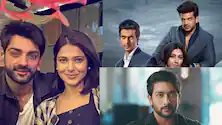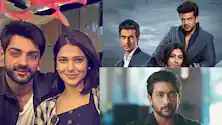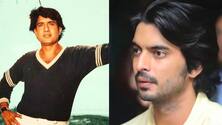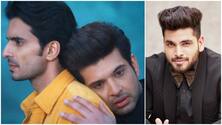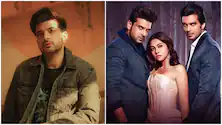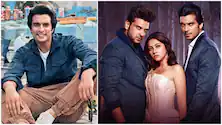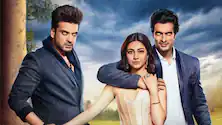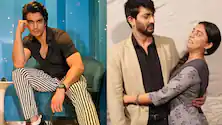EXCLUSIVE INTERVIEW! Gashmeer Mahajani: Guru Dutt's Pyaasa Made A Mountain Of Difference To Me
'The master of feelings', 'a true film man' and the list goes on...There are several epithets used to describe the iconic filmmaker-actor Guru Dutt. Each time you hear his name, your heart swells with immense respect for him and his incredible body of work. He was mercurial and enigmatic, both on and off screen. His portrayal of the heartbreak of middle-class romanticism made him one of the finest storytellers that we have ever seen. Dutt's hunger for love and his suppressed passion translated into some great pieces of art which have been immortalized in the pages of Indian cinema.
The enduring mystery around this legend has swept generation of cinema lovers off their feet. Over the years, Guru Dutt's films and his approach towards his craft has become a textbook for filmmakers and students of cinema. Among the countless fans who are enamored with this genius of a man is actor Gashmeer Mahajani.


Take a look back at some of Guru Dutt's masterpieces and you will comprehend that the maverick director's films are not just sheer black and white poetry but also self-reflective in nature. Each one of them contains a piece of his real-self. Well, isn't it rightly said, 'Art is all about connecting with people's emotions. It's personal and at the same time, universal?'
In an exclusive tete-a-tete with Filmibeat, Gashmeer Mahajani opens up on idolizing Guru Dutt, shares some interesting trivia about what went behind the scenes of some of the iconic songs of the legendary filmmaker and much more.

'The Song 'Babuji Dheere Chalna' from Aar Paar Made Me Follow Guru Dutt's Cinema'
Q. You have always mentioned that you are highly inspired by Guru Dutt & it's him who made you think about films in the first place. Which was the first film of Dutt Saab's that you watched & do you recall your reaction to it?
A. The first film of Guru Dutt Saab that I saw was Pyaasa. It made a mountain of difference to me with the language of cinema that I got introduced to while watching that film. More than that, I completely for the first time ever, thought that okay, I want to watch this man's movies was when I saw 'Babuji Dheere Chalna' song from Aar Paar in which there was a massive use of silhouettes. There is this lady (Shakila) dancing by a table where there are a few men sitting, smoking and watching her. The men are in silhouettes...you can only see their outlines and white smoke being blown into the light while the girl is standing in front of them and dancing. There's just a couple of feet of difference between the men sitting at the table and the lady dancing. She's completely lit up and the men are in silhouettes. I just felt that was a piece of art and that I have to watch movies of whoever made this song or this movie. That's how I started out with Pyaasa.
Q. What drew you towards this legendary filmmaker? And today, do you observe any of that influence in the work you have done so far when you sit back & reflect upon your cinematic journey?
A. What drew me towards the filmmaker was that 'Babuji Dheere Chalna' song and yes, his influence stays, I think even today in the last fifty-sixty years. Nobody can shoot a song the way Guru Dutt Saab did for his movies. I think the way he shot his songs was epic. And that one song made me follow his cinema. It made me start watching his movies.

'I Have Followed Guru Dutt's Work So Much That I Just Want To Experiment With Designing Songs In My Films'
Q. Be it the use of alluring black & white close-up shots, light-shadow play or the ability to weave multiple thematic layers in the narrative, Dutt knew how to ignite great cinema on screen. As someone who plans to get behind the camera in the future, do you feel his cinematic legacy is a huge source of inspiration to you when it comes to breaking away from formulas?
A. Ya, like whenever I see people discussing cinema and they take Guru Dutt Saab's name, though they haven't in detail watched his movies the way they need to watched or deserved to be watched by any student of cinema, I often see a lot of actors around me throwing out names like 'Arey, Guru Dutt Saab ka woh 'Waqt ne kiya kya haseen sitam', kya woh light ka shaft aata ha upar se..oh my god, etc etc,' Woh toh kamaal ka tha hi...but if that's the only reference point for Guru Dutt Saab's songs that you have then I feel there's nobody more shallow than you because I feel every song that he shot...If you are talking about tight close-ups, the song in the bedroom with Meena Kumariji and Rehmaan Saab in Sahib Biwi Aur Ghulam ('Na Jao Saiyan Chhuda Ke') where she is not letting him go and trying to keep him in her bed, isn't that shot in close-ups?
Now,
when
we
talk
about
language
in
cinema,
this
is
what
we
speak.
Why
is
the
song
shot
in
close-ups?
It's
entirely
shot
in
supremely
tight
close-ups
in
the
bedroom
because
he
really
needed
the
intimacy
to
come
across
in
the
song.
So,
you
will
hardly
see
a
wide
shot
in
the
entire
song.
It's
all
close-ups.
So
not
just
the
actor's
intimacy
is
coming
into
play,
but
the
filmmaker's
language
of
cinema
is
what
I
talk.
He
has
used
his
camera,
his
magnification
and
his
lens
to
create
the
intimacy
on
a
subconscious
level
in
the
mind
of
the
viewers
as
well.
So,
it's
not
just
the
intimacy
portrayed
by
the
actors,
the
filmmaker
is
also
through
the
language
of
his
film-making,
portraying
that
intimacy,
creating
that
feel
of
intimacy
in
the
audience's
mind.
From
the
same
movie,
if
you
see
the
song
'Saakhiya
aaj
mujhe
neend
nahi
aayengi' in
which
all
the
background
dancers
are
all
girls.
In
the
entire
song,
you
don't
see
a
single
background
dancer's
face.
Only
the
girl
who
is
dancing
at
the
forefront
,
the
lead
dancer,
you
can
only
see
her
face
throughout
the
song.
Now
why
was
that
done?
Because
when
Guru
Dutt
Saab
landed
on
the
set,
he
didn't
like
a
single
background
dancer.
He
wasn't
happy
with
them
at
all,
the
way
they
were
looking.
They
had
limited
amount
of
time
to
shoot
that
song
because
of
location
and
budget
issues.
He
couldn't
cancel
the
shoot
as
well
because
the
background
dancers
were
not
up
to
the
mark.
Since
he
couldn't
cancel
the
shooting,
he
created
a
light
pattern
where
all
the
background
dancers
are
kept
in
silhouettes.
They
are
all
in
the
dark,
you
can
only
see
their
outlines
so
that
the
frame
doesn't
look
empty.
But
he
didn't
want
to
show
their
faces
because
he
wasn't
very
happy
with
them.
So,
he
just
created
that
light
pattern
and
set
that
tone
for
the
entire
song.
It
works
brilliantly
well
so
you
can
see
only
the
lead
dancer's
face.
There
is
not
a
single
background
dancer's
face
visible
in
a
single
shot
throughout
the
song.
So,
these
fun
things
are
great
to
know
like
what
went
into
the
making
of
a
particular
song
and
today,
people
say
'Arey
silhouette
create
kiya
hai,
oh
my
god,
kya
piece
of
art
hai!'
Arey
piece
of
art..aap
jaante
bhi
ho
kyun
kiya
thha
and
kaise
kiya
thha?
What's
the
reason
behind
it?
So,
these
finer
details
are
so
nice
to
study
from
his
pieces
of
work.
'In
Babuji
Dheere
Chalna',
the
first
song
that
I
described,
the
art
of
Chiaroscuro
was
introduced
for
the
first
time
in
India.
Chiaroscuro
is
a
pattern
of
lightening
which
was
never
used
in
Indian
cinema.
Guru
Dutt
Saab
introduced
that.
Chiaroscuro
is
where
the
structures
are
lit
up.
No
where
in
Indian
cinema
were
structures
lit
up
earlier.
'Babuji
Dheere
Chalna'
is
the
first
song
where
the
structure
is
lit
up
like
the
pillars
that
you
see
in
the
song
and
the
textured
walls
at
the
back.
Earlier,
only
the
subject
i.e
only
the
actors
used
to
be
lit
up
in
cinema.
Nobody
bothered
the
lighting
of
the
structures
to
create
a
visual
impact.
'Babuji
Dheere
Chalna'
was
the
first
song
where
Chiaroscuro
was
used.
So,
all
these
lovely
things
that
I
got
to
learn
by
watching
the
making
of
his
movies
and
you
know,
figuring
his
way
of
shooting
a
song.
So
for
me
now
in
my
Marathi
films
recently,
I
have
shot
songs.
I
am
working
as
an
actor
in
those
movies,
but
I
have
requested
the
production
houses
to
let
me
design
those
songs.
So,
somewhere
that's
inspired
from
the
kind
of
work
that
he
has
done.
I
have
followed
it
so
much
that
I
just
want
to
experiment
with
designing
songs
in
my
films
as
well
and
I
try
and
attempt
it.

'A Lot Of People Nowadays Pretend To Be Suffering Thinking That People Will Call Them Great Artists'
Q. I have often heard people say that Guru Dutt's films are a testimonial to the popular quote, 'Great art comes from great suffering'. What's your take on that?
A. It does apply to Guru Dutt Saab that great art comes from great suffering. (pauses). But I think that's just one aspect of it. The art also comes from a lot of deep rooted passion for the craft of making movies that he had in himself. It does stem from that. It stems from a lot of study; self-study and study of the things that are happening around you and how you want to grab them in the lens. There are multiple facets to it. I think you just can't limit it to saying that great art comes from great suffering, although suffering was a very big part of Guru Dutt Saab's life. A lot of people nowadays pretend to be suffering thinking that people will call them great artists (laughs). So, it's quite funny how people use this quote so shallowly and easily nowadays.
Q. Speaking about the genius artist, renowned poet-writer Kaifi Azmi who worked with him in Kaagaz Ke Phool had once said, "Unki naakamiyaabi mein ek baat yeh bhi thhi ki woh waqt se pehle paida ho gaye." In fact, some of Dutt's popular works were celebrated only post his demise. Do you think he was a visionary way ahead of his time?
A. I would completely agree to that considering a few of his films like Kaagaz Ke Phool or many others as well. But I think, despite of that, it's quite credible that he also tasted a lot of commercial success. A few of his films didn't do well which are classics till date. For example, Kaagaz Ke Phool. But apart from that, there were a lot of films that did commercially well and are pieces of art at the same time. So, having that blend of art and commerce together on a such a great level is a big achievement. So, he was ahead of his times, there's no doubt about it. But he did taste success as well. So, it's a feel good factor for fans like me.

'I Don't Think There Should Be A Biopic On Guru Dutt Because It's Scary To Even Think About It'
Q. Lastly, if any one plans to make a film on Guru Dutt's life, what do you think would be the biggest challenge?
A. I feel if anybody plans to make a biopic on Guru Dutt Saab, the biggest challenge would be playing the man himself. I feel anybody would only be able to try and play it and not actually play it. Also, I feel scared thinking that anyone including the most brilliant actors of our times would end up turning his portrayal into more of a first copy. I don't know...its not possible to wholly and wholesomely portray the genius that he was very realistically at the same time. So, I feel it could only end up being a first copy. For example, like you have an iPhone which is original and you go to any of the gulf countries where on the streets, you can buy an iPhone at 20 percent of its cost which is a first copy. It looks like an iPhone completely, functions like that, but can shut off any day at any moment. (laughs) I feel playing the man himself would be the biggest challenge. I don't think there should be a biopic on him because it's scary to even think about it.
Post Guru's Dutt's demise, Kaifi Azmi who shared a close bond with him, had paid homage to the legend with a nazm in one of his video interviews. A part of that tribute read, "Rehne ko sada koi deher mein aata nahin koi, tum jaise gaye aaise bhi jaata nahin koi. Ek baar toh khud maut bhi ghabra gayi hogi, yun maut ko seene se lagaata nahin koi. Darta hoon kahi khushk na ho jaaye samundar, raakh apni kabhi aap bahaata nahi koi. Saaki se gila tha tumhe maikhaane se shikwa. Ab zeher se bhi pyaas bujhta nahin koi. Mana ke ujaalo ne tumhe daag diye thhe, beraat dhale shama bujhata nahin koi, Rehne ko sada koi deher mein aata nahin koi, tum jaise gaye aaise bhi jaata nahin koi."
The master director left for his heavenly abode decades ago, but his cinematic universe intrigues Gashmeer and many of us even today, and will continue to do so for the years to come!




 Click it and Unblock the Notifications
Click it and Unblock the Notifications





